The first part of Room 4 was originally the new chapel was built behind the tower of Cola di Benvenuto Servitori as part of the extension of the palace in ca. 1330. This chapel was consecrated in 1331 to SS Louis of Toulouse and Magnus. (The earlier chapel, which was first documented in 1325, was probably under the Sala Maggiore).
Fragments of the fresco decoration of the “new” chapel survive around the windows on the right wall. These windows were presumably closed when the later Cappella dei Priori (now Room 21) was built behind them in 1443-50.
The rest of Room 4 belongs to the extension of the palace along what is now Corso Vannucci that was carried out in 1429-43.
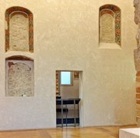
Patron Saints of Perugia (early 14th century)



Ambrogio Maitani is usually credited with the carving of the originally polychrome marble figures of in the lunette above the Portale dei Santi Patroni (the entrance to the Palazzo dei Priori). They probably represent SS Herculanus, Laurence and Constantius, who were named together as the patron saints of Perugia in 1316. The figures were removed for restoration in 1993 and moved to the gallery, while copies were placed in the original location above the portal.
Madonna di Sant' Agostino (early 14th century)
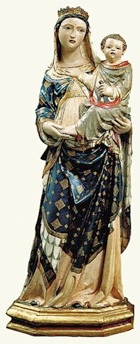
The Madonna is modelled as a full-length figure in regal costume, wearing a crown and carrying the baby Jesus on her hip. He is also regally dressed, and holds a bird in His right hand (probably a finch, which is a symbol of the Passion). Recent restoration has revealed the original polychrome decoration, which is in a good state of preservation that is unusual in a work of this age. The work is sometimes attributed to Ambrogio Maitani.
Panels from Montelabate (ca 1330)
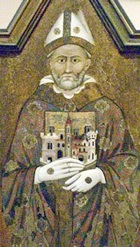
The panels depict:
-
✴St Herculanus holding a model of the Duomo (illustrated here), with St Peter (dressed as a bishop and holding the key to Heaven) on the back; and
-
✴St Laurence, with St Paul (badly damaged) on the back.
The panel of St Herculanus is particularly important for its depiction of what is now Piazza IV Novembre as it was in the 14th century.
Madonna and Child with saints (ca. 1330)
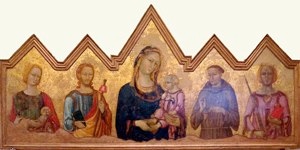
This dossal, which has recently been attributed to the Maestro dei Dossali di Montelabate, was moved from the nuns’ choir of San Tommaso to the gallery in 1879. It depicts the Madonna and Child with SS Agnes, James, Francis and Catherine of Alexandria. The dossal was placed in the present frame as part of a restoration in 1920.
Dossal (early 14th century)
These two panels from what was originally a double-sided dossal entered the gallery from the Convento di Sant’ Antonio di Padova, Paciano Vecchio, outside Perugia in 1872. They are dated on stylistic grounds to the early 14th century and are the autograph works of the so-called Maestro di Paciano.
In fact, the Convento di Sant’ Antonio did not exist until 1496, so it was clearly not the original location of the dossal. It is possible that it was originally commissioned for the Convento di Monteripido, which, like Sant' Antonio, belonged to the Observant Franciscans. The friars of Monteripido commissioned another double-sided altarpiece of similar width in 1502 (see the Monteripido Altarpiece - Room 23); they may have passed their original altarpiece to Sant' Antonio at that point.
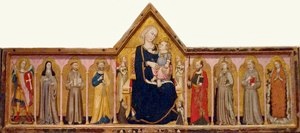
The front of the dossal depicts the Madonna and Child enthroned with angels. Unusually, the baby Jesus wears a triple-knotted cord around His waist, a reference to the Franciscan habit. Two figures kneel before the throne:
-
✴a layman, presumably the donor, on the left; and
-
✴a Franciscan on the right. He wears a patched cloak over his habit and has a rayonant halo that suggests that he has been beatified. If the hypothesis as to the original location of the dossal is correct, this figure is almost certainly the Blessed Giles, the early Franciscan who lived on the site of the later Convento di Monteripido.
Four saints occupy fictive aedicules to each side:
-
✴on the left:
-
•St Michael Archangel (perhaps because Monteripido is just outside Porta Sant' Angelo);
-
•St Clare;
-
•St Francis (who holds a text that refers to his stigmatisation); and
-
•St Peter; and
-
✴on the right:
-
•St Paul;
-
•St Louis of Toulouse;
-
•St Antony of Padua; and
-
•St Mary Magdalene (represented as a hermit, clothed only in her long hair).
The back of the dossal, which is damaged, originally depicted five scenes from the Passion. The central one, which was almost certainly a Crucifixion, has been completely lost.
Panels from a triptych (early 14th century)
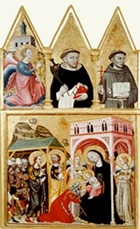
The surviving panels (the first of which is illustrated here) depict:
-
✴the Adoration of the Magi with three figures above :
-
•the Archangel Gabriel;
-
•St Peter Martyr; and
-
•St Francis; and
-
✴the Presentation of Christ with three figures above:
-
•St Louis of Toulouse;
-
•St Dominic; and
-
•the Virgin Annunciate.
The iconography of the narrative scenes depends upon that of frescoes (ca. 1320) in the south transept of the lower church of San Francesco, Assisi. This suggests that the triptych was commissioned in the early 1320s, soon after the formation of the Confraternita di San Francesco. It might have been the altarpiece listed in an inventory of its possessions that was made in 1326.
The presence of both Franciscan and Dominican saints in the panels is explained by the fact the confraternities in Perugia that were dedicated respectively to SS Francis and Dominic were closely associated. The early date of the panels suggests that this association was forged from the inception of both confraternities.
Crucifix (early 14th century)
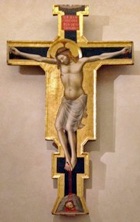
Madonna and Child (early 14th century)
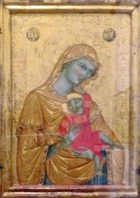
The half-length Madonna and Child are set against gold background. The baby Jesus, who wears a red tunic and sandals, reaches up and clasps the chin of the Madonna in a naturalistic gesture that is in sharp contrast with the otherwise iconic feel of the composition.
Madonna and Child and Crucifixion (ca. 1340)
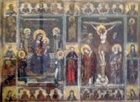
The two main scenes depict:
-
✴the Madonna and Child enthroned, with angels (on the left) and
-
✴the Crucifixion with the Virgin and St John the Evangelist (on the right).
Each of these images is surrounded by figures of saints, including a number of Franciscans.
Stained glass (ca. 1345)
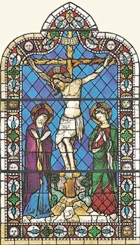
The original window has been attributed to Giovanni di Bonino on the basis of a comparison with the corresponding scene in the window at Orvieto, albeit that the iconography is different in the two works. (The cross in Orvieto is “Y” shaped). The Perugian window is usually dated to ca. 1345 because Giovanni di Bonino was called to Orvieto from Perugia in that year. However, some scholars believe that it predates the window in Orvieto.
Triptych (ca. 1365)
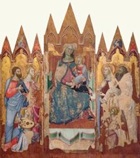
The main panels in this triptych depict:
-
✴the Madonna and Child enthroned;
-
✴an Apostle, St Catherine of Alexandria and a kneeling angel on the left; and
-
✴St Mary Magdalene, Elijah and a kneeling angel on the right.
There are three gables over each of the panels, although the content of those over the central panel has been lost. The other gables depict:
-
✴the Archangel Gabriel flanked by angels (on the left); and
-
✴the Virgin Annunciate flanked by angels (on the right).
Panels from a polyptych (14th century)
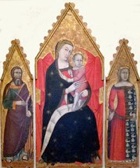
-
✴the central panel depicting the Madonna and Child: and
-
✴two side panels depicting:
-
•St John the Evangelist; and
-
•St Catherine of Alexandria.
Other panels from this polyptych in the Museo Civico, Forlì depict SS Gregory and Mary Magdalene.
Madonna and Child enthroned with angels (ca. 1400)
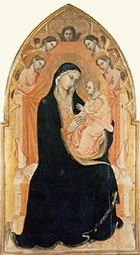
Portable triptych (ca. 1380)
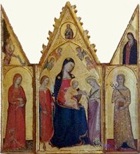
-
✴the mystical marriage of St Catherine, with St Ansanus, with God the Father above (in the central panel):
-
✴St Mary Magdalene, with the Archangel Gabriel above (on the left); and
-
✴St Elizabeth of Hungary (who had been canonised in San Domenico in 1235), with the Virgin Annunciate above (on the right).
Galleria Nazionale: Sala Podiani and Sala Conferenze Rooms 1-3 Room 4
Rooms 5-6 Rooms 7-10 Rooms 11-16 Room 17 Rooms 18-20 Cappella dei Priori
Rooms 22-28 Rooms 29-32 Rooms 33-40 Deposit
Return to Museums of Perugia.
Return to Walk I.
